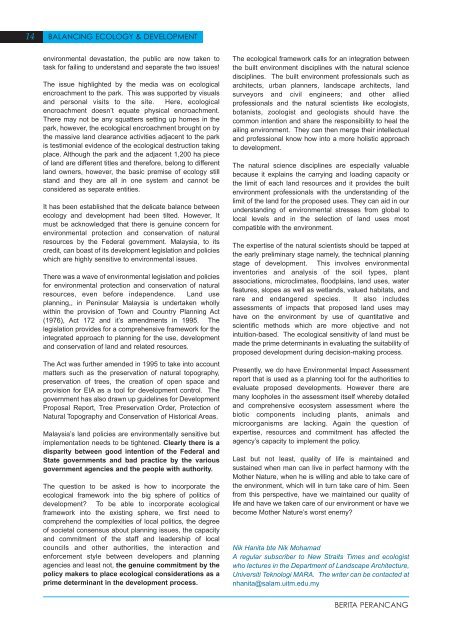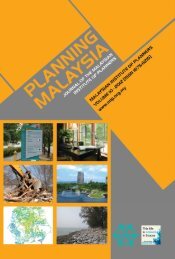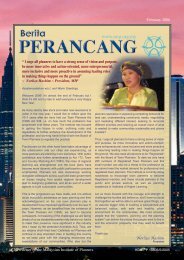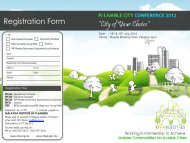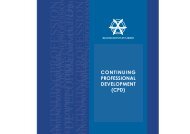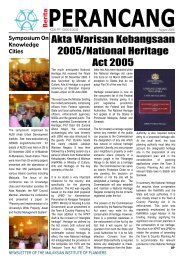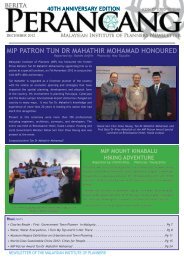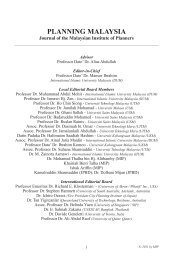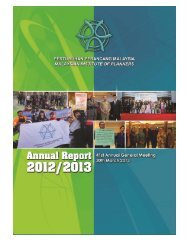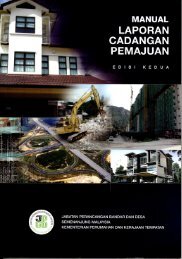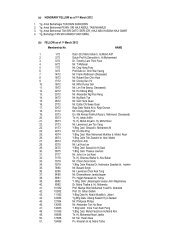14BALANCING ECOLOGY & DEVELOPMENTenvironmental devastation, the public are now taken totask for failing to understand and separate the two issues!The issue highlighted by the media was on ecologicalencroachment to the park. This was supported by visualsand personal visits to the site. Here, ecologicalencroachment doesn’t equate physical encroachment.There may not be any squatters setting up homes in thepark, however, the ecological encroachment brought on bythe massive land clearance activities adjacent to the parkis testimonial evidence <strong>of</strong> the ecological destruction takingplace. Although the park and the adjacent 1,200 ha piece<strong>of</strong> land are different titles and therefore, belong to differentland owners, however, the basic premise <strong>of</strong> ecology stillstand and they are all in one system and cannot beconsidered as separate entities.It has been established that the delicate balance betweenecology and development had been tilted. However, Itmust be acknowledged that there is genuine concern forenvironmental protection and conservation <strong>of</strong> naturalresources by the Federal government. Malaysia, to itscredit, can boast <strong>of</strong> its development legislation and policieswhich are highly sensitive to environmental issues.There was a wave <strong>of</strong> environmental legislation and policiesfor environmental protection and conservation <strong>of</strong> naturalresources, even before independence. Land useplanning,, in Peninsular Malaysia is undertaken whollywithin the provision <strong>of</strong> Town and Country Planning Act(1976), Act 172 and it’s amendments in 1995. Thelegislation provides for a comprehensive framework for theintegrated approach to planning for the use, developmentand conservation <strong>of</strong> land and related resources.The Act was further amended in 1995 to take into accountmatters such as the preservation <strong>of</strong> natural topography,preservation <strong>of</strong> trees, the creation <strong>of</strong> open space andprovision for EIA as a tool for development control. Thegovernment has also drawn up guidelines for DevelopmentProposal Report, Tree Preservation Order, Protection <strong>of</strong>Natural Topography and Conservation <strong>of</strong> Historical Areas.Malaysia’s land policies are environmentally sensitive butimplementation needs to be tightened. Clearly there is adisparity between good intention <strong>of</strong> the Federal andState governments and bad practice by the variousgovernment agencies and the people with authority.The question to be asked is how to incorporate theecological framework into the big sphere <strong>of</strong> politics <strong>of</strong>development? To be able to incorporate ecologicalframework into the existing sphere, we first need tocomprehend the complexities <strong>of</strong> local politics, the degree<strong>of</strong> societal consensus about planning issues, the capacityand commitment <strong>of</strong> the staff and leadership <strong>of</strong> localcouncils and other authorities, the interaction andenforcement style between developers and planningagencies and least not, the genuine commitment by thepolicy makers to place ecological considerations as aprime determinant in the development process.The ecological framework calls for an integration betweenthe built environment disciplines with the natural sciencedisciplines. The built environment pr<strong>of</strong>essionals such asarchitects, urban planners, landscape architects, landsurveyors and civil engineers; and other alliedpr<strong>of</strong>essionals and the natural scientists like ecologists,botanists, zoologist and geologists should have thecommon intention and share the responsibility to heal theailing environment. They can then merge their intellectualand pr<strong>of</strong>essional know how into a more holistic approachto development.The natural science disciplines are especially valuablebecause it explains the carrying and loading capacity orthe limit <strong>of</strong> each land resources and it provides the builtenvironment pr<strong>of</strong>essionals with the understanding <strong>of</strong> thelimit <strong>of</strong> the land for the proposed uses. They can aid in ourunderstanding <strong>of</strong> environmental stresses from global tolocal levels and in the selection <strong>of</strong> land uses mostcompatible with the environment.The expertise <strong>of</strong> the natural scientists should be tapped atthe early preliminary stage namely, the technical planningstage <strong>of</strong> development. This involves environmentalinventories and analysis <strong>of</strong> the soil types, plantassociations, microclimates, floodplains, land uses, waterfeatures, slopes as well as wetlands, valued habitats, andrare and endangered species. It also includesassessments <strong>of</strong> impacts that proposed land uses mayhave on the environment by use <strong>of</strong> quantitative andscientific methods which are more objective and notintuition-based. The ecological sensitivity <strong>of</strong> land must bemade the prime determinants in evaluating the suitability <strong>of</strong>proposed development during decision-making process.Presently, we do have Environmental Impact Assessmentreport that is used as a planning tool for the authorities toevaluate proposed developments. However there aremany loopholes in the assessment itself whereby detailedand comprehensive ecosystem assessment where thebiotic components including plants, animals andmicroorganisms are lacking. Again the question <strong>of</strong>expertise, resources and commitment has affected theagency’s capacity to implement the policy.Last but not least, quality <strong>of</strong> life is maintained andsustained when man can live in perfect harmony with theMother Nature, when he is willing and able to take care <strong>of</strong>the environment, which will in turn take care <strong>of</strong> him. Seenfrom this perspective, have we maintained our quality <strong>of</strong>life and have we taken care <strong>of</strong> our environment or have webecome Mother Nature’s worst enemy?Nik Hanita bte Nik MohamadA regular subscriber to New Straits Times and ecologistwho lectures in the Department <strong>of</strong> Landscape Architecture,Universiti Teknologi MARA. The writer can be contacted atnhanita@salam.uitm.edu.myBERITA PERANCANG
LAND USE PLANNING ANDENVIRONMENTAL PROTECTIONIN MALAYSIAby Ainul Jaria Bt. Maidin*Land planning system was very much influenced byengineering and architectural factors to suit the problemsand meet the demands <strong>of</strong> the needs <strong>of</strong> urban planninginitially. 1 However, with the progress <strong>of</strong> the society, thecentral role <strong>of</strong> the land planning process started to change,as it became more and more complex in nature. This wasperhaps due to the intensity <strong>of</strong> a certain developmentactivity that required determining issues relating tolocation, size and patterns <strong>of</strong> land utilisation. 2The Town and Country Planning Act 1976 provides that thelocal planning authority must consider measures for theimprovement <strong>of</strong> the environment and the management <strong>of</strong>traffic. 3 The local planning authority is also required to haveregard to the existing policies in respect <strong>of</strong> environmentalprotection <strong>of</strong> the state and the nation. 4 The publicparticipation avenues in the planning process provideopportunity for the public to ensure incorporation <strong>of</strong>environmental protection measures. 5 This is achieved byensuring that the report <strong>of</strong> survey undertaken by the localplanning authority is publicised. The local planningauthority is required to consider every representationmade, and incorporate the same into the plan, if theyreflect the aspiration <strong>of</strong> the community and good planningprinciples. Further, the local planning authority in preparingthe detailed planning schemes or layout plans follow aseries <strong>of</strong> planning standards and design guidelines suchas public open spaces provision, car parking space, bufferzones and greening <strong>of</strong> development sites. Thesestandards are aimed at creating a convenient, safe andpleasant urban environment with adequate communityfacilities and public utilities. This shows the extent to whichsound land use planning and the environment is givenpriority by the <strong>Malaysian</strong> government.Planning law can assume an important role in deliveringenvironmental protection as it is primarily concerned withthe orderly management <strong>of</strong> change, which isfundamentally political in nature, providing a frameworkwithin which various issues can be weighed against eachother. 6 Since land use planning may undoubtedly touch onnumerous aspects <strong>of</strong> human life, it goes without sayingthat such control and management <strong>of</strong> the land would beexpected to reflect not only the socio-economic aspirations<strong>of</strong> the community but also to ensure that societal, ethicaland moral aspects <strong>of</strong> land utilisation are not neglected. Therole <strong>of</strong> the planning authority is, therefore, to provide a* Assistant Pr<strong>of</strong>essor, Public Law Department, Ahmad IbrahimKulliyyah <strong>of</strong> Laws, International Islamic University, Malaysia LL.B(Hons.) (IIUM); Master in Comparative Laws (IIUM); Ph.D (UWA,UK); Advocate and Solicitor, High Court <strong>of</strong> Malaya.1Goh, B.L., "Import <strong>of</strong> Urban Planning into Malaysia" in UrbanPlanning in Malaysia, History Assumptions and <strong>Issue</strong>s, (PetalingJaya Malaysia, Tempo Publishing,1991) Chapter Three generally.2Bell, S.& McGillivray, D., Ball & Bell on Environmental Law,5th.ed.(Great Britain, Blackstone Press Ltd., 2000) p.293; Forgeneral discussion on aspects <strong>of</strong> the role <strong>of</strong> the planning law inpromoting environmental protection see McEldowney,J.F.&McEldowney, S.,Environment and the Law, (UK, Longman,1997) p.103; Aspects <strong>of</strong> Britain - Planning, (London, HMSOPublications Centre, 1992) p.1; Wolf, S. and White, E.,Environmental Law, (Great Britain, Cavendish Publishing Ltd.,1995)BERITA PERANCANGFEATURE 15Dr. Ainul Jaria Maidin is an Assistant Pr<strong>of</strong>essor in Public LawDepartment <strong>of</strong> Ahmad Ibrahim Kulliyyah <strong>of</strong> Laws, InternationalIslamic University and an Advocate & Solicitor, High Court <strong>of</strong>Malaya. She can be contacted at ainulj@iiu.edu.my.general, though calculated, framework within whichvarious socio-economic as well as political issues andvalues could be balanced. The local planning authorityupon which the planning powers are vested is an electedbody where ultimate power is with elected members andtherefore, has greater legitimacy in terms <strong>of</strong> making abalanced policy decision to allow or refuse a development.It must be mentioned at the outset that the planning systemis not and cannot be the only method to protect theenvironment. However, no one can disagree with the factthat the process can assume an important role inpromoting environmental protection wherein informationrelating to environmental impacts <strong>of</strong> a development can beconsidered in the planning decision making process. Thissystem has contributed significantly to the protection andenhancement <strong>of</strong> the built environment <strong>of</strong> all towns andvillages throughout Malaysia. 7An organised land use system also can <strong>of</strong>fer opportunitiesto anticipate and forestall environmental harm by refusingdevelopment consent or by separating incompatible landuses. This necessarily leads us to the fact that the landplanning system is principally a system <strong>of</strong> anticipatorycontrol <strong>of</strong> various land use patterns whereby the controllingauthority will not grant any approval for a developmentactivity if adverse impact on the surrounding environmentis envisaged. 8 However, the extent to which planningcontrols can be used to intervene further to preventenvironmental harm remain limited as the land planningprocess itself is not always able to assess the impact <strong>of</strong>planning activity on the environment as well as on theprobable victims <strong>of</strong> such activity since it is mainlyconcerned with location and siting <strong>of</strong> a developmentproject. This is because planning law is reactive andmanagerial rather than protective. 9 Thus, most countries,including Malaysia, have adopted the new perspective <strong>of</strong>town planning which encompasses all the disciplinesmentioned above in order to develop a sustainabledevelopment system, which will be able to meet both thedemands for comfortable human habitation as well asenvironmental conservation. 10at p.334. Franklin, D., et.al., Pollution in the UK.,(London, Sweetand Maxwell, 1995) p.3.3S 8(3)(a) <strong>of</strong> the Town and Country Planning Act 1976.4S 8(4)(a) <strong>of</strong> the Town and Country Planning Act 1976.5S 9(1) <strong>of</strong> the Town and Country Planning Act 1976.6Ibid.7Zainuddin Mohammed, “Key <strong>Issue</strong>s in Environmental Planning inMalaysia,” Federal Department <strong>of</strong> Town and Country Planning,Ministry <strong>of</strong> Housing and Local Government, (Unpublished, 1995) p.1.8Kadouf, H.A., & Ainul Jaria Maidin, “Theory and Practice in LandUse Planning in Malaysia: An Overview,” paper presented at theNational Seminar on, “The Legal Regime <strong>of</strong> Sustainable Land Useand Environmental Development: Policies and Trends,” 9th August2003, Banquet Hall International Islamic University, Malaysia.9Hughes, D., Environmental Law, (UK, Butterworths, 1996) at p.151.10Ibid.


